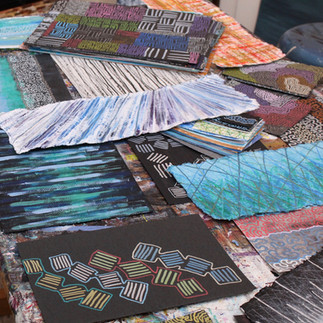Nostalgia and Innovation
- David Joyner
- Jun 20, 2023
- 3 min read
Updated: Jun 21, 2023
I remember as a child of probably around seven or eight years old, I traveled with my family to Lafayette Louisiana to visit my godparents. While we were there, we stopped at the studio of George Rodrigue. The building was on piers, and I believe octagon shaped. He let us in and showed us around. My parents bought a print and the book from his Cajuns series which were all filled with these fat flat black oak trees. This, as I remember it, was before the success of his Blue Dog Series. I remember also being fascinated by the whole experience. Everywhere the smell of paint permeated the air. When we returned home, I emptied everything out of my closet...cloths, toys, shoes...everything. I separated the planks that made up the shelves to let the light bulb above shine through, and set up a makeshift desk. This was not a big closet, but for a time it became my studio. I had supplies for drawing and balsa wood for sculpting.
I forgot about about this for a long time until I was trying to remember when I first thought that I might want to be an artist. I had taken up theatre, which became a passion, to the extent that I ran a high school theatre program for 23 years. Theatre was also my first major. I believe that it shaped my painting aesthetic to more fully consider how groups of paintings are related to each other, and that an exhibition needs to be staged.
I sort of entered visual art from the side door, but more accurately, I saw how different art forms were related. When staging a play, I often think about the tableaux of an old master painting or the color palet from an abstraction. It became important for me (early in college) to study art comprehensively: aesthetics, history, studio, lexicon, design, materials, business, and analysis. I certainly have favorite styles and artists, but I think what fascinates me the most is that art arcs all the way back to the earliest seconds of human awareness. Each artist at some point saw an older artist painting on a body or a cave wall, and fell in as part of a tradition. As a teacher for 30 years of students ranging in age from 5 to probably 80, that arc also seems to apply to how artists evolve a process and a voice.
There is a connection of varied influences including learned techniques, personal memories, and experiences that shape how an artist develops. Each artist, in whatever medium, sits at the nexus between what came before and what will become. Great artists continue tradition or nostalgia while doing more than just kicking the can down the road. Innovation is about not rejecting tradition, but evolving and enhancing the norms. Miles Davis created groundbreaking albums in every style of jazz from the 1940's through the 1990's. Still, he worked within a framework called Jazz. He always surrounded himself with other talented musicians, and gave them space to flourish, while exploring and stretching the boundaries of existing forms. He essentially invented new styles from the foundational process of improvisation.
Painting for me involves periods of looking, reading, experiencing, and processing the many arts from a variety of forms and mediums. I try to employ that transcendental eye, absorbing what has been done by other artists and creatives. This part is the nostalgia. I mean, we are not so different from the earliest peoples. We wonder, love, hunger, and grieve. The studio, hopefully, is my place of innovation. I acknowledge derivatives from previous artists, cultures, and styles, while exploring my filtered inventory of processes and themes. Arriving at a synthesis is the goal. It should be familiar and evocative, but (at its best) also fresh and new.






Comentarios